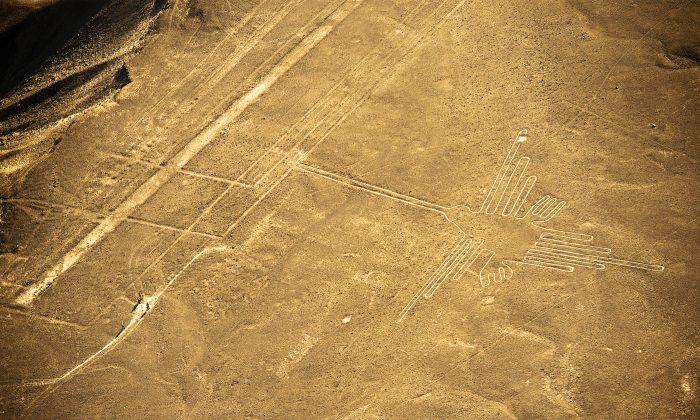Archeologists who based their search on a 50-year-old photo rediscovered a more than 2,000-year-old geoglyph of a killer whale in a remote region of Peru.
The German expedition was searching the Nazca and Palpa valleys, where ancient geoglyphs abound. The location of the specific geoglyph was listed—but it turned out the location listed was incorrect.
Isla had uncovered about one thousand geoglyphs in the Nazca region in the 1990’s, but had never seen one like this. It is not one of the biggest—the orca image is only about 200 feet long, while some of the Nazca figures are over 1,300 feet long—but it is one of the oldest—and is the only orca carving yet discovered.
Isla started searching for the missing geoglyph when he returned to Peru. It took a few frustrating months of searching to find the correct location, but in January 2015, he located the geoglyph in the Palpa valley, about 250 miles south of Peru’s capital, Lima. The geoglyph was in a remote desert region; not even local residents were aware of it.
“It was not easy to find it, because the [location and description] data were not correct, and I almost lost hope,” Isla told LiveScience. “However, I expanded the search area and finally found it a few months later.”

One of the Oldest
The orca geoglyph may be one of the oldest yet discovered. Parts of it were etched into the earth—a technique called ”relief” or “negative relief.” Other parts were built up out of stacked stones.Relief was used by the Nazca culture, which created about 1,500 gigantic geoglyphs between 100 B.C. and 800 A.D.
Stone-stacking was a technique used by the much older Paracas culture, which flourished in the area from around 800 B.C. to 200 B.C. It seems likely that Nazca sculptors found an older Paracas carving and redid it.
Isla and a team of six archaeologists began cleaning and restoring the ancient artwork in March of 2017, and finished in April. The hillside figure was in considerable disrepair; gravity had pulled rocks and water over it, eroding its raised portions and filling the reliefs.
“Being drawn on a slope, it is easier [for it] to suffer damage than [for] those figures that are in flat areas, such as those of the Nazca Pampa,” Isla explained to LiveScience.

Why an Orca?
Researchers from the Commission for Archaeology of Non-European Cultures (KAAK) of the German Archaeological Institute and the Instituto Andino de Estudios Arqueológicos (INDEA) debated the meaning of the geoglyph for years before determining that it represented an orca—a sea creature with powerful spiritual associations for ancient Peruvians—and also showed a “trophy head.”Archeologists decided the figure probably had religious meaning to its creators.
‘Land Traffickers’
This newly re-discovered ancient artifact could go away again, unfortunately. Peru has a law, Law 840, popularly known as the Law of the Jungle, which allows lumber and agricultural companies to seize land which is not being used commercially. This includes huge swaths of tribal lands—and includes some of the land on which the orca geoglyph is located.Peru’s Ministry of Culture wants to take possession of all the land on which the orca figure lies, and to set up guest services to promote tourism. The legal battle has yet to be resolved.
“Both in Nazca and in Palpa, the archaeological heritage, especially the geoglyphs, has been threatened by urban advance and the expansion of the agricultural frontier,” Isla told LiveScience.
“This [has happened] with the lands near the orca geoglyph, where there is currently private property that occupies part of the archaeological zone.”






Friends Read Free